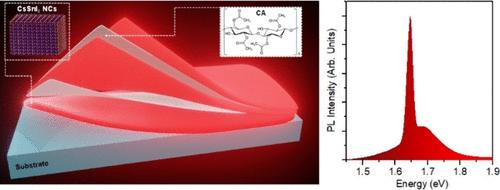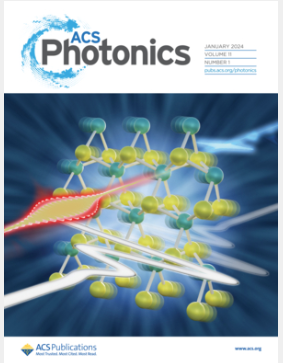室温纳秒级放大的碘化锡钙钛矿纳米结构自发辐射
IF 6.7
1区 物理与天体物理
Q1 MATERIALS SCIENCE, MULTIDISCIPLINARY
引用次数: 0
摘要
卤化铅钙钛矿纳米晶体(NCs)表现出显著的受激发射特性,促进了可见光光谱上高效的光泵浦激光。虽然他们的锡基同行还没有取得这样的成就,但他们提供了一种更环保、无铅的替代品的前景,也扩展了对重要的近红外区域的访问。在这项研究中,我们利用近年来在胶体卤化锡钙钛矿纳米结构合成方面的最新进展,制备了由CsSnI3纳米晶体(NCs)和环保聚合物醋酸纤维素(CA)组成的坚固的逐层异质结构。该结构支持纳秒泵浦放大自发发射(ASE),其阈值低至870 μJ/cm2,净模态增益高达25 cm-1。交替的NC -聚合物薄膜结构不仅增强了高折射率CsSnI3层内的光波导,而且通过顺序的薄膜沉积可以形成均匀的活性层,而不是无序的厚NC膜只能在低温下维持ASE。这种方法为实现实用的无铅钙钛矿基激光技术提供了一条有希望的途径。本文章由计算机程序翻译,如有差异,请以英文原文为准。

Room-Temperature Nanosecond Amplified Spontaneous Emission from Tin Iodide Perovskite Nanostructures
Lead halide perovskite nanocrystals (NCs) exhibit remarkable stimulated emission properties, facilitating efficient optically pumped lasing across the visible spectrum. While their tin-based counterparts do not match such achievements yet, they offer the prospect of a greener, lead-free alternative, also extending access to the important near-infrared region. In this study, we exploit recent advances in the synthesis of colloidal tin halide perovskite nanostructures to fabricate robust layer-by-layer heterostructures composed of CsSnI3 nanocrystals (NCs) and the eco-friendly polymer cellulose acetate (CA). The engineered structures support nanosecond-pumped amplified spontaneous emission (ASE), exhibiting a threshold as low as 870 μJ/cm2 and a net modal gain of up to 25 cm–1. The alternating NC–polymer film architecture not only enhances optical waveguiding within the high-refractive-index CsSnI3 layers, but also enables uniform active layer formation through sequential thin-film deposition, in contrast to disordered thick NC films that sustain ASE only at cryogenic temperatures. This approach presents a promising pathway toward the realization of practical, lead-free perovskite-based laser technologies.
求助全文
通过发布文献求助,成功后即可免费获取论文全文。
去求助
来源期刊

ACS Photonics
NANOSCIENCE & NANOTECHNOLOGY-MATERIALS SCIENCE, MULTIDISCIPLINARY
CiteScore
11.90
自引率
5.70%
发文量
438
审稿时长
2.3 months
期刊介绍:
Published as soon as accepted and summarized in monthly issues, ACS Photonics will publish Research Articles, Letters, Perspectives, and Reviews, to encompass the full scope of published research in this field.
 求助内容:
求助内容: 应助结果提醒方式:
应助结果提醒方式:


